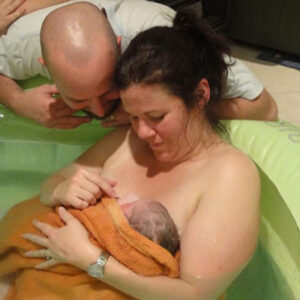
This morning I woke to read the Google newsfeed on Waterbirth and waterbirth evidence. What I found were headlines like “Study: Water Birth Offers No Special Benefits”, “Water Babies: Docs Challenge Growing Trend — Childbirth In A Tub” and my favourite “Water Births May Be Risky For Mother And Newborn”. Had there been a new study to show that waterbirth had no benefits or even poor outcomes? I wanted to know if this was the case as at least 80 percent of my clientele used water at least at some point in their labours.
So I decided to track down the research paper that initiated such headlines. What I found was a clinical report called ‘Immersion in Water During Labour and Delivery’ (American Academy of Pediatrics Committee on Fetus and Newborn & American College of Obstetricians and Gynecologists, 2014) and not a new research paper providing new evidence. I read on in interest.
Waterbirth evidence
I noted that the authors are the American Academy of Pediatrics Committee on Fetus and Newborn (AAPCFN) and the American College of Obstetricians and Gynecologists (ACOG) who do not publicly support waterbirth. I also noted that any mention of the benefits of waterbirth was punctuated with words such as proponents and advocates rather than researchers looking at the benefits and risks associated with waterbirth. What I got was a very clear sense of bias from the outset, in this clinical report.
When exploring the evidence regarding warm water immersion in labour and waterbirth the authors quite rightly pointed out that there is a distinct lack of research on many aspects of warm water immersion and waterbirth. However, there is some research and we can draw conclusions from the limited number of well-designed studies. The Cochrane Collaboration has done just that in their review called ‘Immersion in Water in Labour and Birth’ (Cluett & Burns, 2009).
I n summary, the Cochrane review found:
n summary, the Cochrane review found:
- A significant reduction in pain relief used in labour
- Reduction in the length of the first stage of labour
- No difference in instrumental birth rates, syntocinon being used to speed labour, perineal tear rate or maternal infection
- No differences in babies Apgar scores at five minutes, admission to neonatal nurseries or neonatal infection
- One trial concluding a much greater degree of statisfaction with the birth experience (Cluett & Burns, 2009)
While the Cochrane review was refered to repeatedly in the AAPCFN and ACOG report, the more robust research evidence was played down with the authors focusing more on individual case reports and case series, particularly when discussing complications during labour and birth with waterbirth. Anyone who knows about research understands that these types of research form the lowest level of confidence in the findings whereas the Cochrane review relies on randomised controlled trials in which we can place much greater confidence (National Health and Medical Research Council, 2012). In other words the authors of this clinical report have relied heavily on low level research to promote that waterbirth is unsafe. Subsequently the media have picked up on this and created provocative headlines.
Until we have further well-designed studies on waterbirth, we will not have any more research evidence upon which to make informed decisions regarding waterbirth.
In my opinion, the clinical report by the AAPCFN and ACOG (2014) on immersion in water during labour and birth does not add to our understanding of warm water immersion and waterbirth and is not a report I will be taking on board when I consider my clinical practice. What I will consider is the review by Cluett & Burns (2009) and their findings summarised quite nicely here:
Evidence suggests that water immersion during the first stage of labour reduces the use of epidural/spinal analgesia and duration of the first stage of labour. There is limited information for other outcomes related to water use during the first and second stages of labour, due to intervention and outcome variability. There is no evidence of increased adverse effects to the fetus/neonate or woman from labouring in water or waterbirth.
Written 23 March 2014 for www.pregnancy.com.au as part of the ‘Musings of a Midwife’ series.
Waterbirth: Twisting the research evidence (379 KB)
Download the PDF of this article
Main and featured image Copyright www.spikeyhedgehog.com.au
References
American Academy of Pediatrics Committe on Fetus and Newborn, & American College of Obstetricians and Gynecologists. (2014). Immersion in Water During Labor and Delivery. Pediatrics, 133(4), 758–761. doi:10.1542/peds.2013-3794, from http://pediatrics.aappublications.org/content/early/2014/03/18/peds.2013-3794.full.pdf+html
Cluett, E. R., & Burns, E. (2009). Immersion in water in labour and birth ( Review ). Cochrane Database Syst Rev 2009. doi:10.1002/14651858.CD000111.pub3
National Health and Medical Research Council. (2012). Table 1 NHMRC Evidence Hierarchy: Designations of “levels of evidence” ac cording to type of research question. Retrieved March 23, 2014, from www.health.qld.gov.au/healthpact/docs/gen-docs/lvl-of-evidence.pdf
Page revised on 20th December 2021


Recent Comments